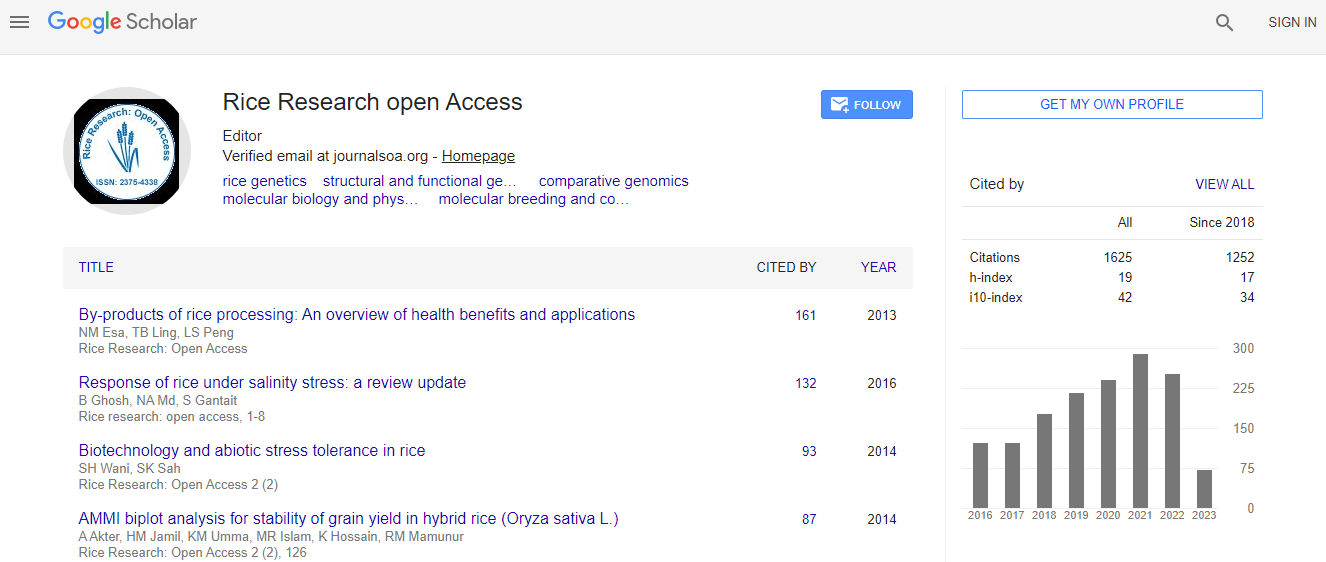Editorial
Understanding the Fragrance in Rice
| Arpit Gaur1, Shabir Wani H1*, Deepika Pandita2, Neha Bharti2, Ashok Malav3, Asif Shikari B2 and Ashraf Bhat M1 | |
| 1Division of Genetics and Plant Breeding, SKUAST-K, Jammu & Kashmir, India | |
| 2Ceneter for Plant Biotechnology, SKUAST-K, Jammu & Kashmir, India | |
| 3Department of Plant Breeding and Genetics, MPUAT-Udaipur, Rajasthan, India | |
| *Corresponding Author : | Shabir Wani H Division of Genetics and Plant Breeding SKUAST-K, Srinagar-190025 Jammu and Kashmir, India Tel: 9419035566 E-mail: shabirhussainwani@gmail.com |
| Received: January 22, 2016; Accepted: January 24, 2016; Published: January 26,2016 | |
| Citation: Gaur A, Shabir Wani H, Pandita D, Bharti N, Malav A, et al. (2016) Understanding the Fragrance in Rice. J Rice Res 4:e125. doi:10.4172/2375-4338.1000e125 | |
| Copyright: © 2016 Gaur A, et al. This is an open-access article distributed under the terms of the Creative Commons Attribution License, which permits unrestricted use, distribution, and reproduction in any medium, provided the original author and source are credited. | |
Abstract
Aroma in plants is a result of numerous volatile and semi volatile compounds present within Fragrance in grain rice is the most attractive trait that provides a premium price in the market. Continuously increasing demand for fragrant rice in global market gained a special attraction of rice breeders and forced them for considering rice grain aroma among major objectives for commercially improved rice varieties. Since, aromatic varieties are very rare these may be considered among most precious treasure of India and can also be considered as national asset and pride. The fragrance of rice plays an important role in affecting the market value and consumers’ preference [1-3]. These characteristic aromatic rice have been reported in three different genetic sub populations of rice viz. Group V (Sadri and Basmati), indica (Jasmine), and tropical japonica [4] of more than 250 volatile and non-volatile compounds reported in both fragrant and nonfragrant rice varieties, a novel compound namely 2-acetyl-pyrrolin (2AP) has been significantly found as primary contributor in imparting the unique pop-corn like aroma in rice [5-8]. It has been reported that both aromatic and non-aromatic rice varieties have the characteristic aroma compound 2AP and the only difference lies in concentration between them [9]. In a comparative study, compounds alkanals, alk-2-enals, alka(E)-2,4-dienals, 2-pentylfuran, 2-acetyl-1-pyrroline and 2-phenylethanol have been reported as major contributors in total aroma profiling of rice. Besides, 2-acetyl-1-pyrroline and other previously known aroma imparting volatile compounds, recently few more novel compounds viz. 2-amino acetophenone and 3-hydroxy- 4,5-dimethyl-2(5H)-furanone (found in high levels in Basmati 370) [10], and guaiacol, indole and p-xylene in Black rice [11], were found to be mainly responsible for its unique flavour. The strength of aroma greatly depends upon the concentration of 2AP in rice grain tissues, however the odour threshold level of rice is 0.1 ppb, its range of concentration in aromatic rice varieties varies from 6 ppb to 90 ppb for the milled rice and 100 ppb to 200 ppb in brown rice, depending upon the variety such as in Basmati rice (0.34 ppm), Jasmine rice (0.81 ppm) and Texmati (0.53 ppm).

 Spanish
Spanish  Chinese
Chinese  Russian
Russian  German
German  French
French  Japanese
Japanese  Portuguese
Portuguese  Hindi
Hindi 
